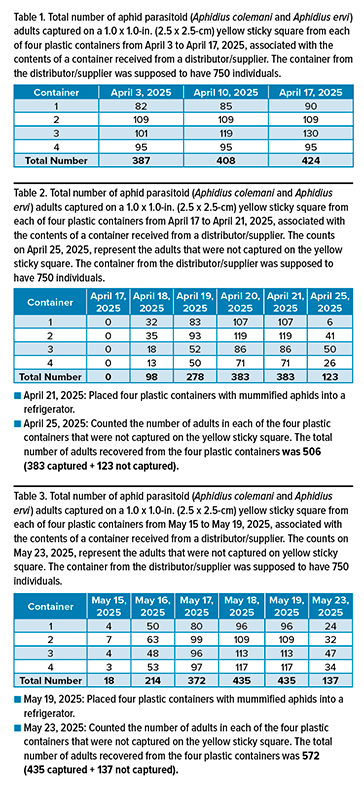6/30/2025
Aphid Parasitoids: What Are You Getting?
Dr. Raymond A. Cloyd

The quality or number of live individuals associated with biological control agents—such as parasitoids, predators and entomopathogenic nematodes—is important to ensure the success of biological control programs. Consequently, greenhouse producers, after releasing biological control agents in greenhouses, should determine if the individuals received from distributors/suppliers are viable by sampling biological control agent products (e.g. slow-release sachets, release cards or containers).
Mummified aphids and sawdust carrier.
 Aphid parasitoids, such as Aphidius colemani and Aphidius ervi, can be released into greenhouse production systems to manage or maintain aphid populations below plant-damaging levels on horticultural crops, including ornamentals and vegetables.
Aphid parasitoids, such as Aphidius colemani and Aphidius ervi, can be released into greenhouse production systems to manage or maintain aphid populations below plant-damaging levels on horticultural crops, including ornamentals and vegetables.
Four plastic containers with sawdust and mummified aphids.
Aphidius colemani females lay eggs into the green peach aphid (Myzus persicae) and the melon/cotton aphid (Aphis gossypii), whereas Aphidius ervi females lay eggs into the potato aphid (Macrosiphum euphorbiae) and foxglove aphid (Acyrthosiphon solani). Aphidius colemani and Aphidius ervi are commercially available from distributors/suppliers of biological control agents as a mixture in containers (Figure 1) with sawdust as the carrier and mummified (parasitized) aphids.
 As part of our research focus at Kansas State University on quality assessment of biological control agents, three experiments were conducted to determine the number of adults of both aphid parasitoid species that emerged from mummified aphids associated with a commercially available product. The containers indicated that there were 750 individuals. The contents of each container were distributed among four plastic containers (Figure 2) to ensure ease and accuracy when counting the number of parasitoid adults of both species. Each container had a 1 x 1 in. (2.5 x 2.5 cm) yellow sticky square attached to the lid underside using double-sided sticky foam (Figure 3).
As part of our research focus at Kansas State University on quality assessment of biological control agents, three experiments were conducted to determine the number of adults of both aphid parasitoid species that emerged from mummified aphids associated with a commercially available product. The containers indicated that there were 750 individuals. The contents of each container were distributed among four plastic containers (Figure 2) to ensure ease and accuracy when counting the number of parasitoid adults of both species. Each container had a 1 x 1 in. (2.5 x 2.5 cm) yellow sticky square attached to the lid underside using double-sided sticky foam (Figure 3).
Yellow sticky square attached to underside of lid of plastic container.
In the first experiment, the number of adults captured on the yellow sticky square (Figure 4) were counted every seven days for three weeks. In the second and third experiments, the number of adults captured were counted every day for five days. In addition, after counting the number of adults captured on the yellow sticky square, the four plastic containers were placed into a refrigerator set at 30F (-1.1C) for five days to kill any remaining adults that hadn’t been captured on the yellow sticky square. The number of adults from each of the four plastic containers was counted. (The data associated with each experiment are presented in Tables 1 through 3.)
 After combining the data from the four plastic containers for each experiment, 750 adults were not captured or recovered in the three experiments. A total of 424 adults were captured on the yellow sticky square in the first experiment, 506 adults were captured and recovered in the second experiment, and 572 adults were captured and recovered in the third experiment, which was a 56%, 67% and 76% recovery rate, respectively.
After combining the data from the four plastic containers for each experiment, 750 adults were not captured or recovered in the three experiments. A total of 424 adults were captured on the yellow sticky square in the first experiment, 506 adults were captured and recovered in the second experiment, and 572 adults were captured and recovered in the third experiment, which was a 56%, 67% and 76% recovery rate, respectively.
Aphidius colemani and Aphidius ervi adults captured on yellow sticky square.
A greenhouse producer, after releasing parasitoids into a greenhouse, may be under the assumption that enough individuals are present to manage or maintain aphid populations below plant-damaging levels. However, if not enough individuals are present, then aphid populations could increase and reach plant-damaging levels. Aphid populations in greenhouses are all females and each female can produce 100 live nymphs within 30 days, which produce their own offspring that develop into another generation of females. The high reproductive capacity and rapid development enables aphid populations to increase and spread quickly among horticultural crops in a greenhouse. Consequently, if not enough parasitoids are released, then the parasitoids won’t be able to maintain aphid populations below plant-damaging levels, thus necessitating the need to apply an insecticide.

In conclusion, the quality of biological control agents, based on the number of live individuals, is important to ensure the success of biological control programs. If a quality assessment indicates that not enough live individuals were released into the greenhouse, then the distributor/supplier should be contacted immediately. GT
Raymond A. Cloyd is a Professor and Extension Specialist in Horticultural Entomology/Plant Protection at Kansas State University in Manhattan, Kansas. He can be reached at (785) 532-4750 or rcloyd@ksu.edu.